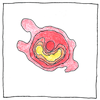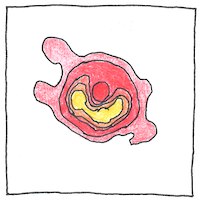John Michell
astrophysics

|
Black hole
John Michell began by considering whether the distance and size of a star could be determined by measuring how its gravity affected diminution of the velocity of its light. Considering Newton’s law of gravity and assuming gravity affects each particle of light, Michell realized that if a star were only 500 bigger than our sun its own light could not escape its surface.
Einstein taught
Einstein’s theory of relativity shows that Michell was somewhat wrong. Photons have no mass, so they are not affected by gravity, per se. Instead, black holes bend space so much that no path leads away from it.
Eye splice
A sailor makes an eye splice by unraveling the end of a multi-strand rope, looping the unraveled part so that the eye has the desired size and the unraveled strands come back to the standing part of the rope, loosening the strands of the standing part, and weaving the unravelled strands into it so that the left-twisting strands are fed below left-twisting strands, and right-twisting strands below the right-twisting strands. At its best, an eye splice is a permant loop whose strength approaches the rope’s strength. To splice rope into a circle, called a grog splice, take a section of rope, unravel both ends and weave them together.



A black hole is like what happens when an unstoppable bullet hits an impenetratable wall. You could be trapped without an answer to the riddle, or you could think outside the box.
See also in The book of science:
Readings in wikipedia:
Other readings: